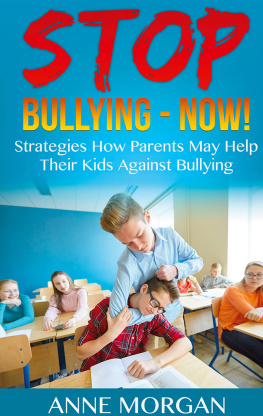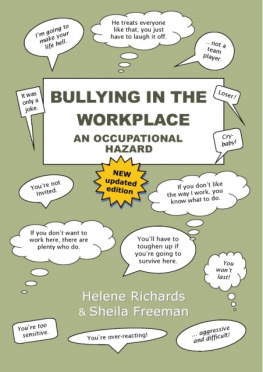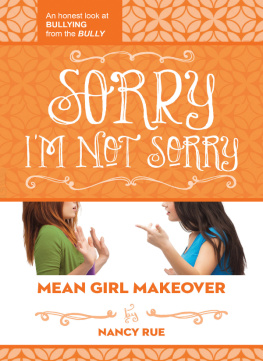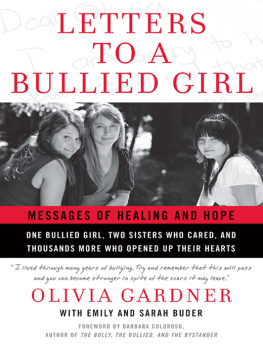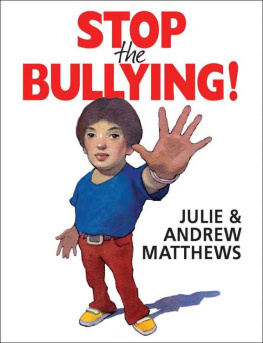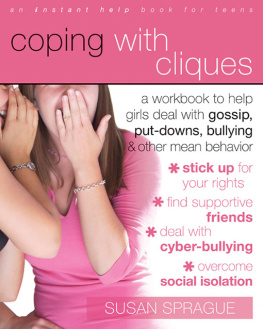
We hope you enjoyed reading this Touchstone eBook.
Sign up for our newsletter and receive special offers, access to bonus content, and info on the latest new releases and other great eBooks from Fireside and Simon & Schuster.

or visit us online to sign up at
eBookNews.SimonandSchuster.com
Thank you for purchasing this Touchstone eBook.
Sign up for our newsletter and receive special offers, access to bonus content, and info on the latest new releases and other great eBooks from Fireside and Simon & Schuster.

or visit us online to sign up at
eBookNews.SimonandSchuster.com

TOUCHSTONE
Rockefeller Center
1230 Avenue of the Americas
New York, NY 10020
www.SimonandSchuster.com
Copyright 2003 by Cheryl Dellasega, Ph.D., and Charisse Nixon, Ph.D.
All rights reserved, including the right of reproduction in whole or in part in any form.
Touchstone and colophon are registered trademarks of Simon & Schuster, Inc.
Sample letter and response on pages 209-10 reprinted with permission from STUDIO 2B Collection, 11-13, copyright 2002, Girl Scouts of the United States of America, 420 Fifth Avenue, New York, NY, 10018, www.girlscouts.org.
ISBN: 978-0-7432-4987-4 (print)
ISBN: 978-0-7432-5364-2 (eBook)
DESIGNED BY ELINA D. NUDELMAN
Library of Congress Cataloging-in-Publication Data is available.
ISBN 0-7432-4987-9
To the woman who made this happen, my agent, Laureen Rowland, and to the mysterious man who has been doing my laundry and fixing my meals.
Cheryl
To my two precious girls, Katie and Abby, for all your trusting love and unconditional acceptance. You have been and continue to be the best teachers of all.
Charisse
Contents

Girl
Wars
INTRODUCTION

Annas thirteenth birthday is only a day away when her two best friends inform her with mock sadness that they wont be coming to her sleepover party.
Tina asked us to go to the movies with her. Thats way more fun than watching videos at your house and playing those stupid games your mom comes up with, they snicker, linking arms and walking away.
An older girl begins to make fun of newcomer Monicas scrawny build whenever they pass each other in the halls of their small rural high school. Even though fifteen-year-old Monica switches from wearing her favorite skirts and dresses to jeans, soon everyone is calling her chicken legs and cackling when she passes.
At ten, Lucy hates playground. Every day when the teacher is distracted, a boy will swoop up and snap the back of Lucys new bra, which barely contains her B-cup breasts. Worse yet is the betrayal of girls, who cluster together and laugh when that happens. Even Lucys former friends have started sticking out their chests mockingly and strutting behind her.
Day after day, fifteen-year-old Shantal and her crowd of friends face off against fourteen-year-old Erika and her group. In the cafeteria of their inner-city school, Shantal calls Erika a slut because she is dating Reese, a good-looking seventeen-year-old. In return, Erika shoves past Shantal and mutters bitch just loud enough to be heard. The confrontations grow more and more heated until one day between classes Erika punches Shantal in the face, an encounter that escalates into a brawl requiring police intervention.
What do these young women and their friends have in common? All are caught up in the whirlwind of relational aggression, wounded by the words and actions of another girl. Even Erika and Shantal, who work to maintain tough girl stances at all costs, are scared, hurt, and insecure underneath.
Relational aggression (RA), also called female bullying, is the use of relationships, rather than fists, to hurt another. Rumors, name calling, cliques, shunning, and a variety of other behaviors are the weapons girls use against one another on an everyday basis in schools, sports, recreational activities, and even houses of worship. The increasing incidence of physical confrontations between girls, like Erika and Shantals are often preceded by escalating relational aggression.
Most women can recall an incident of RA in their own past, but the seriousness of these behaviors is reaching new proportions, resulting in criminal charges, school shootings, and suicides. Why are todays girls so willing to be this cruel to one another?
When psychologist Mary Pipher wrote her bestselling book Reviving Ophelia in the mid-1990s, she suggested we need to work together to build a culture that is less complicated and more nurturing, less violent and sexualized, and more growth producing. If anything, the world of adolescent girls is now more complicated, violent, and sexualized as well as less nurturing than when Dr. Pipher first proposed her agenda for change.
Todays young women are subtly influenced to interact in ways that reduce rather than enhance their underlying power to connect with one another. Bombarded with messages about their physical appearance at an early age, they are expected to dress provocatively while maintaining straight A averages and excelling at sports. They are labeled as mean Queen Bees but given no alternatives for more positive behaviors. Their bodies are reaching physical maturity earlier and earlier, yet their cognitive skills remain anchored in adolescence. Role models for todays teens are not powerful women who have succeeded because of their persistence and kindness to others, but rather superstar singers acting like sexy schoolgirls and movie stars firing machine guns or using martial arts on opponents while wearing skintight jumpsuits. No wonder young women find themselves in a state of extreme confusion, unsure of how to relate to either themselves or others.
The good news is that all across the country, mothers, girls, and others are finding ways to help adolescents feel more secure about their own abilities and safe in their relationships with others. Slowly, their efforts are changing the girl poisoning culture Mary Pipher first lamented nearly a decade ago, transforming behavior from cruel to kind.
Do all girls have the capacity to be kind? We believe girls are not inherently cruel, and that although behaviors such as jealousy, gossiping, and joining cliques may be normal in terms of what we expect, they are not what we have to accept. Based on our work with hundreds of young women in both our professional and personal lives, as well as extensive research, evaluation, and input from other experts on the subject, Charisse and I know that not only can girls be kind, they feel better about themselves when they are. We call this behavior confident kindness, because the ability to be caring and supportive of others is only meaningful if it comes from an inner sense of security and self-esteem.
It is our role as adults to guide young women to form more positive self-identities, which will in turn lead to more supportive relationships with others. Thats what this book is all about. How can mothers, young girls, or any other concerned party overcome RA? In this book, input from four important sources is used to identify twelve key strategies that both girls and adults can use.
Next page

